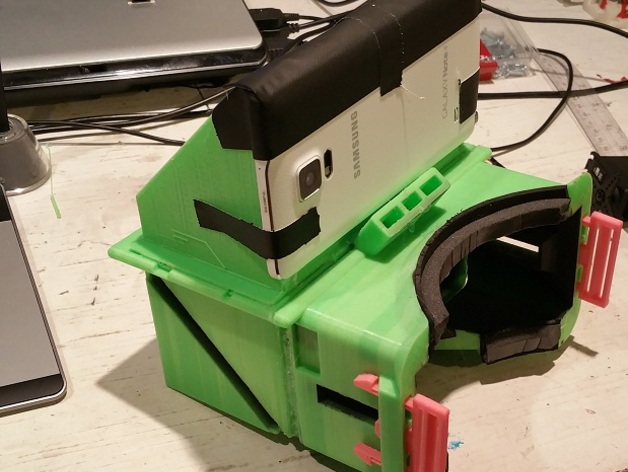Entirely too excited about Microsoft’s Hololens, the DIY community has leaped on the challenge to make some hardware before the real deal comes out. [Sean Hall] has an excellent 3D printed prototype that makes use of the Pepper’s Ghost illusion to create a “hologram” for this pair of unique VR goggles.
Similar to other DIY virtual reality goggles we’ve seen, [Sean] has 3D printed the enclosure — but instead of slapping the smart phone right in front of your eyes, it’s mounted above the goggles, reflecting off of a mirror and then a piece of transparent plexi-glass, which produces a hologram like effect thanks to the concept of Pepper’s Ghost illusion.
The problem with any of these reflection-based-holograms is they aren’t always that easy to see, so [Sean] is planning to try out some 1-way reflective car tint to get a more visible reflection while still being able to see through the image. He also plans to add gaze tracking with some open-source software called Project Haytham. It’s a depth sensor using a Kinect, head tracking using a Playstation Move and maybe even a leap motion controller for virtual object manipulation.
Check out the current state of this hack in the clip after the break.















It would be cool to use a monochrome lcd as the mirror to make the “holograms” appear opaque on demand. (or compensate for a bright day)
What about adding an LCD without backlight (to see through, as used in the DIY projectors), and tweak the contrast setting of it, depending on the ambient light.
Sounds like the developer could take apart one of the those rear-view mirrors that auto-adjust for brightness for inspiration. I believe they too use the technology you are describing, and it would probably work well here. Just for starters, my 2007 Jeep Patriot uses one; they can’t be expensive at this point.
My 2001 Chevy Silverado uses an electro-chromic rearview mirror. I’m certain those could be found in any junk yard.
Replacement electrochromic mirrors are available on eBay starting at $9.
Also, electrochromic film is available, also a dev kit for around $40.
Search for “electrochromic film” on eBay.
Add a Pico projector module to show onto the main screen. Laser modules are super bright and eye safe – as you look onto the reflection
bit more like a castAR then
with clipons ;p
the music scared me away from the video
Don’t worry, Aphex Twin can get waaaaaaay weirder than that.
Years ago I recall seeing a prototype device for the iphone which used three semi transparent mirrors. This allowed you to project images in three planes allowing for objects to appear physically separated. The downside is that it cut the resolution along the Y-axis to 1/3rd of the original.
Nicely done. Possibly silly question, but the upper mirror? Couldn’t the phone just face down?
I’m guessing you’d still have the phone in view if it were only using one mirror. This means you’re only seeing the reflection and not the original source as well.
Image would be mirrored then.. With two mirrors, it’s like multiplying two negatives to get a positive.
Ah, good call Celebraces, I think you’re correct.
Jesper, I thought of that too, but it should be easy enough to account for that in software / content.
“Teleprompter”
HUD
Cool! Do you know Universe2Go, it works the same way… https://vimeo.com/86226276
That has to be painful to look at and use, no correcting optics to make the phone at the same focal distance as the world.
I’m so glad you said Pepper’s Ghost, so that the language purists wouldn’t jump down your throat, causing the rest of us severe eye muscle strain from the rolling.